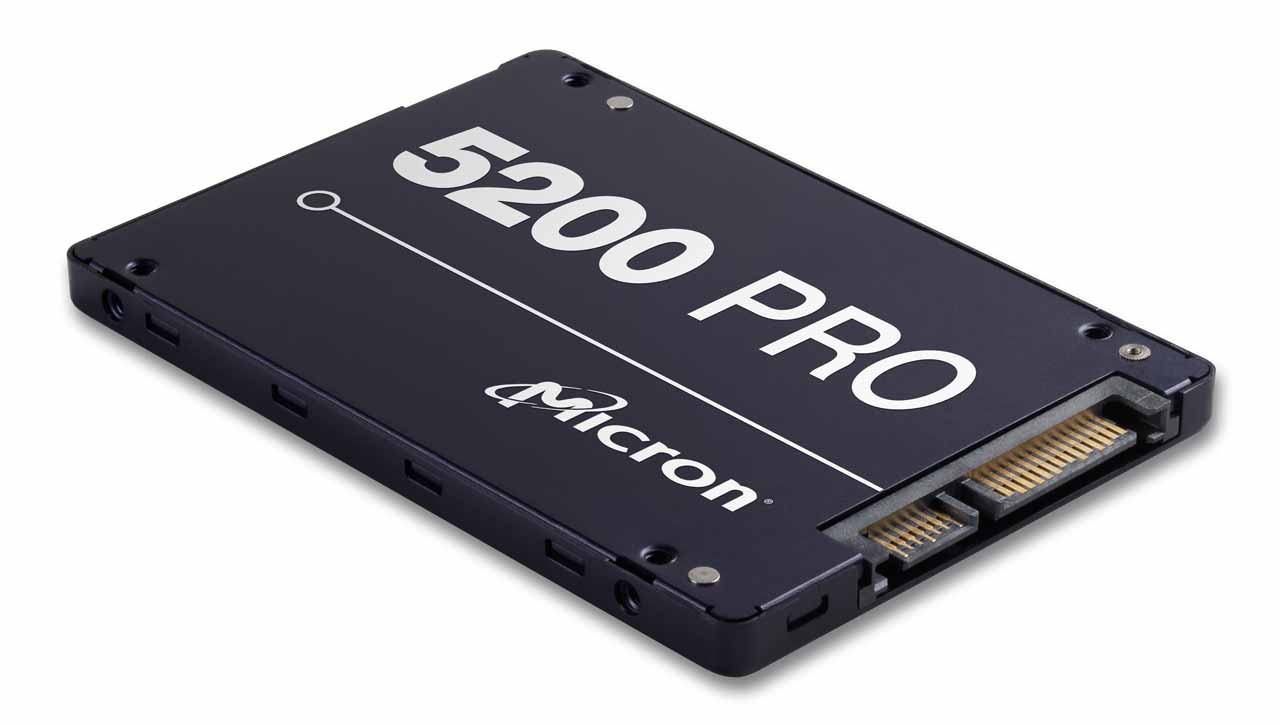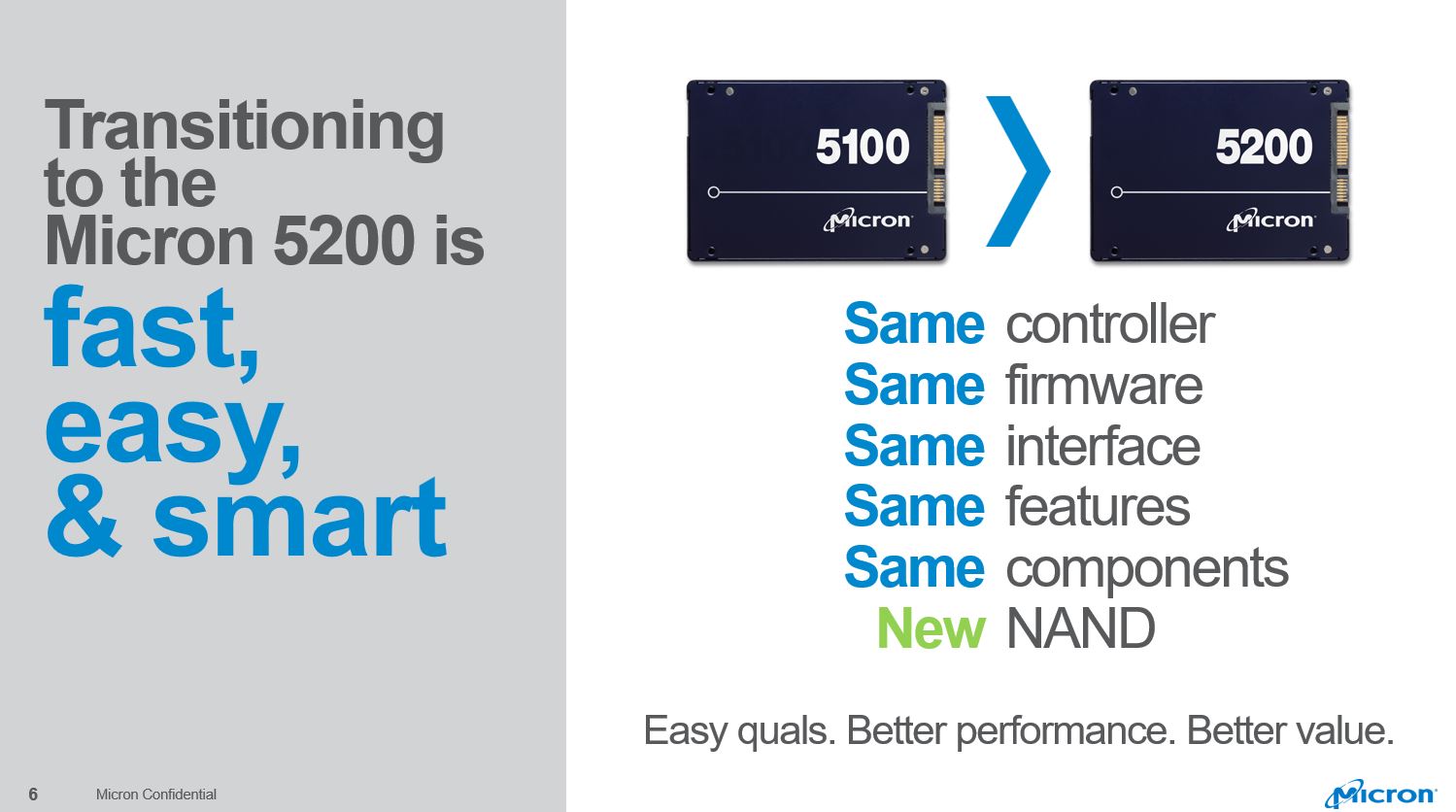Micron Infuses 5200 Series SSDs With 64-Layer NAND
Micron and Intel have been upgrading all of their SSDs with their jointly-developed 64-layer 3D TLC NAND. We've seen the first wave of Micron's new flash make waves in the consumer market with the ultra-competitive Crucial MX500, and Intel just refreshed its NVMe lineup with the similarly impressive 760p NVMe SSDs. Now it's time to bring the same 64-layer NAND, and the cost benefits of denser NAND, to the enterprise.
As with most SATA SSDs, Micron's 5100 series comes in the 2.5" form factor. Micron split the 5200 series into Eco and Pro models that offer 1 and 2 DWPD (Drive Writes Per Day) of endurance, respectively. This is a change from Micron's 5100 series, which also had a stout Max model that offered up to 5 DWPD of endurance. Micron's decision to eliminate the high-endurance model is logical; server administrators are migrating more intense workloads to NVMe SSDs.
Unlike the drives we see on the consumer side, the 5200 series tops out at 7.68TB. That's impressive, but it merely matches the previous-generation 5100 series. The 5200 SSDs use the same Marvell Dean SSD controller and do not use TLC caching. That helps to ensure steady and consistent performance, which is a key requirement in the data center. Micron also notably abandoned the eTLC (Enterprise TLC) branding for its TLC NAND.
| Capacity | 480GB Eco | 960GB Eco | 1.92TB Eco | 3.84TB Eco | 7.68TB Eco | 960GB Pro | 1.92TB Pro |
|---|---|---|---|---|---|---|---|
| Sequential Read / Write (MB/s) | 540 / 520 | 540 / 520 | 540 / 385 | 540 / 520 | 540 / 520 | 540 / 520 | 540 / 520 |
| Random Read / Write IOPS | 81,000 / 33,000 | 95,000 / 28,000 | 95,000 / 22,000 | 95,000 / 17,000 | 95,000 / 9,500 | 95,000 / 32,000 | 95,000 / 32,000 |
| Endurance (PB) | 2.27 | 5.95 | 0.87 | 1.75 | 3.5 | 7.7 | 8.4 |
Most of the performance ratings are similar to the 5100 series, though the Pro series provides 2,000 more peak random read IOPS. The 7.68TB Eco model, which has the lowest random write performance of the lineup, gains an additional 500 random write IOPS. It's obvious from the performance specifications that Micron has tailored the higher-capacity models for less-intense workloads. These high-capacity models are good replacements for the front-bay 10K and 15K HDDs we see disappearing from many server chassis, so even the paltry 9,500 write IOPS is more than enough to replace an entire row of mechanical disks.
Both the Eco and Pro models feature a 3.0/3.6W read/write power draw. Micron improved the Eco models with an additional ~1 DWPD of endurance, while the Pro series steps back from a 1-3 DWPD rating to ~2 DWPD.
The SATA market is becoming more commoditized with each outing. While most of the hot development action is happening on the NVMe side, SATA continues to serve the majority of the enterprise. As Micron points out, boring is good. Aside from the new NAND, the new drives are essentially the same from a qualification standpoint. That reduces qual times for companies that have already invested in the 5100 series, which ultimately reduces cost.
While reduced qual times makes the 5200-series sticky with previous customers, it doesn't do much to draw in new customers. Micron is leaning on its competitive pricing for that. Micron launched the 5100 series with prices that ranged from $0.45 to $0.75 per GB, but the new 64-layer NAND helps to reduce prices to $0.35 - $0.50 per GB.
Get Tom's Hardware's best news and in-depth reviews, straight to your inbox.
Micron's 64-layer NAND has already led to ultra-competitive pricing on its MX500 SATA SSDs, and the same flash also contributes to Intel's much lower pricing on the new 760p NVMe SSD. Both of these models are priced much more competitively than comparable Samsung products, so it will be interesting to see if Micron and Intel can leverage the cost savings to chip away at Samsung's leading market share in the data center.
The SSDs come with all the normal enterprise trimmings we expect with this class of SSD, such as power fail protection, TCG and AES encryption, end-to-end data path protection, and a five-year warranty.

Paul Alcorn is the Editor-in-Chief for Tom's Hardware US. He also writes news and reviews on CPUs, storage, and enterprise hardware.

